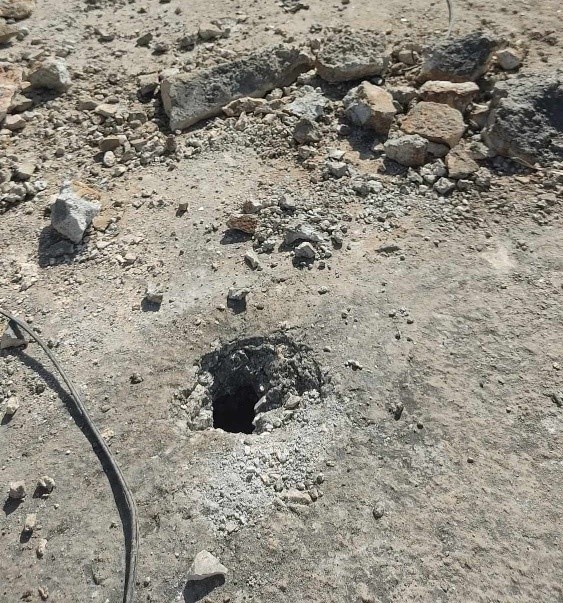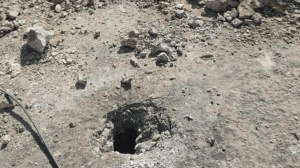On Thursday, 19 September 2024, an Israeli special forces unit of the Israeli occupying forces (IOF) infiltrated and raided the town of Qabatiya southern Jenin Governorate, occupied West Bank, launching a ten-hour-long military attack. During this military attack, the IOF killed seven Palestinians, injured around 15 others, destroyed and damaged Palestinian public and private properties, levelled over 300 meters of paved streets, as well as the Martyrs roundabout at the northern entrance of the town, and besieged students and teachers in a school and a number of employees in their places of employment.
During the military attack, the IOF subjected four of the seven killed Palestinians to degrading and inhumane treatment by discarding their bodies from rooftops and then proceeding with collecting them by military bulldozers, before withholding their bodies. This degrading treatment of Palestinian bodies undermines fundamental human rights, and constitutes a brutal form of dehumanisation of the Palestinian people. Notably, the IOF routinely employs collective punishment tactics to punish the dead and their families by depriving them of a dignified burial, inflicting ongoing emotional torment, and using them as ‘bargaining chips’. Since the start of 2024, the Israeli authorities held the bodies of approximately 25 percent of Palestinians killed, according to Al-Haq’s documentation.
Israel’s raid and military attack on Qabatiya epitomises the consequences of Israel’s illegal presence as an Occupying Power in the occupied Palestinian territory (oPt), as recently affirmed by the International Court of Justice (ICJ) in its Advisory Opinion. The IOF killed five Palestinians in the targeting of the Lubani building, one Palestinian by a drone strike targeting his vehicle, and another in close proximity to a protest against Israel’s brutal military attack on the town.
The Targeting of the Lubani Building: The Killing of Five Palestinians and Degrading Treatment and Desecration of Palestinian Bodies
According to Al-Haq’s documentation, at approximately 10:30 am on Thursday, 19 September 2024, an Israeli special forces unit infiltrated the area of Jabal Zakarneh, north of the main road running through the town of Qabatiya, via several civilian vehicles with Palestinian license plates, towards the Lubani family building. Upon arrival, the IOF encircled the Lubani building and raided several homes and buildings in the vicinity of the building, detaining all individuals inside and confiscating their mobile phones; ultimately imposing a tight military cordon, except southward, where the Martyr Izzat Abu Al-Rub Secondary School for boys is located, trapping around 450 students and staff inside for over five hours.
The Lubani family building is a two-storey building, with each floor containing two housing units, with a total of around 19 residents. At the time of the attack, Ahmad Abed Al-Hameed Lubani, 27, Fadi Jawdat Hanaysha, 28, Mohammed Khaled Abu Al-Rub, 24, his cousin Omar Hamza Abu Al-Rub, 25, and Shadi Sami Zakarneh, 36, were present in the first floor of the building. The IOF fired live ammunition and different types of projectiles at the Lubani building. Then, the IOF shouted at the five Palestinians ordering them to surrender.
Refusing to turn themselves in, exchange of fire was heard, as four of the Palestinian men —Ahmad Lubani, Fadi Hanaysha, and cousins Omar and Mohammed Abu Al-Rub—climbed a wooden ladder to the rooftop while Shadi Zakarneh remained on the first floor. As soon as the four reached the rooftop, they were completely exposed to the IOF, who immediately opened fire. The Palestinian men were subjected to heavy gunfire, additional projectiles, and an airstrike from an Israeli drone, leaving a missile crater on the western side of the rooftop.

A picture showing the crater caused by a strike from an Israeli drone on the Lubani building
- Al-Haq field researcher, 20 September 2024 (c)
Ahmad Lubani was shot and as a result fell off the rooftop onto corrugated roofing sheets (colloquially known in Arabic as ‘Zinco boards’), while the other three men remained lying on the rooftop. Despite being in a state of complete incapacitation, the IOF continued to fire at the three young men, depriving the injured of any possibility to survive. This indicates a clear intention to kill. The IOF also denied access to ambulances and paramedics to the Lubani building area, further denying the young men medical care and treatment.
Meanwhile inside the Lubani building, Shadi Zakarneh was positioned in one of the rooms on the first floor. The IOF frequently fired at the building. After almost three hours from besieging the building, the IOF discovered the exact position of Shadi, which was followed by sounds of bullets, a bombing, smoke rising, after which fire ignited in the apartment where Shadi was positioned. The civil defence teams were able to extinguish the fires hours later, when they discovered a burnt body, believed to belong to Shadi.
As Israeli military bulldozers approached the eastern side of the building, Israeli soldiers managed to reach the rooftop firing live ammunition at the bodies of the Palestinian men, who were lying dead for hours. One bulldozer began a partial demolition of the eastern apartment on the first floor. Then, it attempted to reach the bodies of the four killed Palestinians on the rooftop using its long arm, with the help of the soldiers present on the roof. The soldiers then decided to throw the bodies off of the roof, from approximately 12-14 meters height, by stomping on the bodies with their shoes. This scene was captured and recorded by several nearby residents’ cameras. The bulldozer later used its shovel to move the bodies, which remain withheld by the Israeli authorities to this day.
Drone Strike on a Vehicle, Killing One Palestinian
During the attack, Mustafa Faisal Zakarneh, 23, was driving close to the Lubani building when he exited his vehicle and fired at the positions of some Israeli military jeeps. Mustafa then got back into his vehicle and drove away. As the vehicle reached a side street, an Israeli drone launched at least one missile at the vehicle, killing Mustafa immediately. The vehicle caught fire, but bystanders were able to recover his body and transport him to a medical centre, where he was pronounced dead. The use of drone strikes in targeting Palestinians, including in carrying out extrajudicial killings and targeted executions, has been increasingly employed by the IOF. Between 1 January and 19 September 2024, out of the at least 376 Palestinians killed by the IOF, 106 Palestinians, or around 28 percent, were killed in drone strikes.
Israel’s Shoot-to-Kill Policy Claims Another Palestinian Life
A group of Palestinian youths and demonstrators had gathered east of Jabal Zakarneh, to protest the Israeli attack. While some threw stones at the Israeli military jeeps, others merely observed. At around 7:40 pm, an Israeli soldier fired two bullets at Mohammad Omar Kameel, 21, who was present in the area, hitting him in the head and chest. Mohammad was transported by an ambulance to a medical centre in Qabatiya, where doctors announced his death after failed attempts to revive him. Whether Mohammad was a bystander or had joined in the stone-throwing, he posed no imminent threat to the IOF. The shooting of Mohammad, twice, in his upper body is yet another example of Israel’s shoot-to-kill policy. Notably, of the at least 815 Palestinians killed by live ammunition at the hands of the IOF between 1 January 2022 and 19 September 2024, around 65 percent were shot in the upper body, approximately 13 percent sustained injuries across their entire bodies, and for about 20 percent of those killed by live ammunition, the specific locations of their injuries could not be verified by Al-Haq.
An Array of Crimes
For over two years, Israel has intensified its oppression and military attacks in the West Bank, especially in northern areas, including Jenin Governorate, with further escalation since the start of the ongoing genocide. Israeli military raids and attacks in these areas are characterised by heavy military force, including snipers, the deployment of a range of vehicles—most notably D9 bulldozers—and the use of airstrikes. The IOF routinely raids homes in these targeted areas, vandalises and destroys them, arrests and detains residents, and frequently employs practices meant to humiliate Palestinians. The alarming escalation of these large-scale, aggressive, and lengthy IOF military attacks and raids has severely disrupted daily life and led to the injuring and killing of Palestinians, as well as the destruction of their homes, properties, and infrastructure. According to Al-Haq’s documentation, the IOF killed at least 1007 Palestinians, including 227 children, between 1 January 2022 and 19 September 2024. Of those killed, around 31 percent were in the Jenin Governorate.
Al-Haq has also documented the commission of several violations during the military attack. Around 12 women and children were trapped inside the Lubani building for around three hours, as the IOF fired live ammunition and different types of projectiles at the building. The IOF used a drone to enter and search the building, and communicate with its residents who were present inside. Instead of evacuating these women and children to safety, the IOF have endangered their lives, and subjected them to intimidation and terrorism, prohibited under Article 33 of the Fourth Geneva Convention. Similarly, the IOF’s decision to carry out this attack in broad day-light during the week lead to spreading fear and terror among the entrapped students and staff members in the nearby school for several hours. Furthermore, the military attack has resulted in damages to public and private properties, including the levelling of infrastructure, and a military jeep crashing into a public transportation vehicle injuring two passengers. The attack also included obstruction of journalists work, including by use of live ammunition, injuring one child standing next to the journalists.
The military attack on Qabatiya and the killing of seven Palestinians by Israeli special forces constitute an array of crimes. First, the killing of the four Palestinian young men by the targeting of the Lubani Building, as well as the killing of Mustafa Zakarneh by a drone strike, constitutes an extrajudicial targeted execution, whereas lethal force must be used as a measure of last resort where necessary to counter an imminent or grave threat to life or physical integrity, and when less violent means are not or would not be effective. This action is illegal under international law as it represents arbitrary deprivation of life in violation of Article 6 of the International Covenant on Civil and Political Rights, and the war crime of wilful killing per Article 8(2)(a)(i) of the Rome Statute of the International Criminal Court. The latter classification of crime may apply in relation to the killing of Mohammad Kameel, whereas both the two bullets fired hit the upper body parts of Mohammad, which exemplifies a clear intent to kill.
The military attack also involved the desecration of the bodies of the killed Palestinians, by subjecting them to degrading treatment and inhumanely discarding them from rooftops and subsequently collecting them with military bulldozers before withholding their bodies. This violates international humanitarian law, which states that the dead must be respected and protected and requires the return of human remains and personal effects of the dead to the families.[1] Such an outrageous degrading treatment may amount to the war crime of ‘committing outrages upon personal dignity’ under Article 8(2)(b)(xxi) for the ICC Rome Statute. Furthermore, withholding of bodies and denying the families a dignified burial amount to collective punishment, which blatantly violates Article 33 of the Fourth Geneva Convention. Notably, in 2016, the United Nations Committee against Torture concluded that Israel’s withholding of Palestinian bodies is contrary to the prohibition on torture and inhuman or degrading treatment, and called on Israel to “take the measures necessary to return the bodies of the Palestinians that have not yet been returned to their relatives as soon as possible so they can be buried in accordance with their traditions and religious customs, and to avoid that similar situations are repeated in the future”.[2]
As long as Israel continues to enjoy impunity for its crimes and human rights violations while the international community fails to hold it accountable, Israel will continue to escalate its violence and oppression against the Palestinian people and commit unimaginable atrocities. Accordingly, we call on Third States to assume their legal responsibilities, including by ensuring that Israel effectively and immediately complies with the ICJ’s provisional measures orders and ends the ongoing genocide in Gaza, and upholding their obligations as clearly outlined by the ICJ in its Advisory Opinion, Legal Consequences Arising From the Policies and Practices of Israel in the Occupied Palestinian Territory, including East Jerusalem. To end Israeli impunity, States must, inter alia, impose sanctions and a two-way arms embargo against Israel, hold dual-national Israeli perpetrators accountable under their national jurisdictions, exercise universal jurisdiction, and cooperate with investigative and/or prosecutorial bodies, such as the International Criminal Court and the Commission of Inquiry on Palestine.


